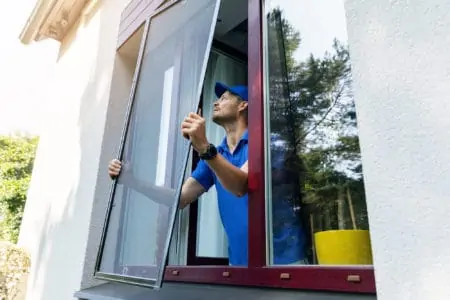Have you ever tried to use a doorknob only to discover it was all wobbly? Do you have a doorknob that won’t turn or one that fell off? Then you’re likely dealing with loose screws or dirt buildup inside the locking mechanism.
Fear not, for I will show you how to fix a loose doorknob depending on the location of the screws.
Key Takeaways
- Identify the type of doorknob: Exposed screws are the easiest to fix, while hidden screws require more steps.
- Locate and tighten screws: For exposed screws, simply tighten them with a screwdriver; for hidden screws, you may need to remove the doorknob and faceplate to access the backplate.
- Use the right tools: You may need a Phillips screwdriver or an Allen wrench depending on the type of screws in your doorknob.
- Consider replacement: If the doorknob is old, broken, or cannot be fixed by tightening screws, it may be time to replace it altogether.
Why Does My Doorknob Keep Getting Loose?
At some point, all residences and businesses will encounter loose doorknobs or handles. When this happens, the handle pulls away from the door and might even jiggle as you attempt to use it.
Thankfully, reattaching a loose doorknob or one that has fallen entirely off is not difficult. Floppy doorknobs are a nuisance and need to be dealt with.
If a doorknob keeps becoming loose, it’s likely due to one of the following reasons:
- There are screws missing from the door plate.
- There are loose screws on the door plate.
- There is dirt buildup inside the mechanism.
- The doorknob is old.
- Some parts might be loose and just need adjusting.
How to Fix a Doorknob With Hidden Screws
The majority of door lock systems have visible screws that are very simple to remove. Others utilize concealed fasteners that can be accessed by disassembling the faceplate and doorknob.
Some people even have old Kwikset doorknobs, with long screws and outdated mechanisms.
When learning how to tighten a loose doorknob, it’s important to know that there are two types of hidden screws you might be dealing with.
Some doorknobs have set-screws (hidden behind the faceplate), while others are spring-loaded with hidden screws. We’re going to learn how to fix both of them.
What You’ll Need
- Flashlight.
- Allen wrench.
- Screwdriver.
- Paper clip or firm wire.
For Hidden Hexagonal Set Screw
There’s no one way to do it because some knobs have different screw sets. If yours has a hexagonal screw-set, read on.
1. Locate the Screws
Find the small round slot, which is typically placed on the side of the internal knob’s shaft. Peek through the hole with a flashlight. The hexagonal-shaped screw should be visible.
2. Tighten the Screw
Grab an Allen wrench and tighten the screw. If this doesn’t fix the issue, proceed to the next step.
3. Remove the Knob
You might have to remove the knob to access the screws located in the backplate. To do this, grab your Allen wrench and insert it inside the small round hole. Twist it counterclockwise to remove the screw.
4. Tightening the Backplate
Pull the faceplate gently until the backplate is revealed. Grab a fitting screwdriver and tighten every loose screw that is visible on the backplate. Put the faceplate back in place and fasten it by screwing the hex screw back in its original position.
For a Spring-Loaded Knob With Hidden Screws
If your lock system has a spring-loaded clip, you have to remove the knob to gain access to the screws on the backplate.
1. Expose the Backplate
Find the little slot along the internal knob’s shaft. Hold the knob and insert a firm piece of wire or a paper clip through the hole. Press to spring the knob and remove it by sliding it out of the spindle.
Remove the rose collar so that the backplate is revealed. You should now see the screws that connect the lockset mechanism to your door. If you notice they are loose, that might be why your doorknob is wobbly.
2. Reassemble the Mechanism
Take a screwdriver and tighten all the loose screws. Put the rose collar back in place and fasten it by turning it clockwise. Put the knob back into the spring-loaded spindle, then turn it counterclockwise until it snaps back where it was initially.
How to Fix a Doorknob With Exposed Screws
Exposed screws are located on the front of the faceplate. These are the easiest to fix because all you have to do is tighten them.
What You’ll Need
- Philips head screwdriver.
1. Locate the Screws
Exposed screws are normally found on the faceplate of the interior knob.
2. Tighten the Screws
Grab a Phillips head screwdriver compatible with the screws and turn them clockwise to tighten them.
When to Replace a Broken Doorknob
Want to know if your doorknob can be repaired or requires replacing? You first have to figure out what’s causing the problem.
The lock mechanism may fail to function simply because it is dusty or dry and needs graphite lubrication. A latch that does not function properly may be the result of an ill-fitting door.
For major lock issues, it is usually advisable to contact a locksmith or to replace the lock completely. The majority of interior doorknobs are affordable to replace. It is rarely necessary to have interior doorknobs professionally fixed unless they are exceptionally valuable.
FAQs
Need to understand more? Here are some of the most common questions I see around this topic.
Conclusion
As you can see, fixing a loose doorknob is mostly about identifying the location of the screws that need fastening. Once you know how to fix a loose doorknob, you only need the right wrench/screwdriver. And maybe a little bit of patience.










